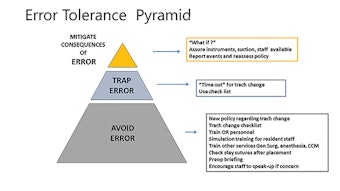Tech Talk: Business Processes – Precursor to EMR Selection
Selecting the right electronic medical record (EMR) software solution is critical. The wrong choice can be devastating. These implementations are not just IT projects but require participation and effort from everyone—users, clinicians, and technologists alike. Without a full team effort and proper project oversight, these endeavors can easily spiral out of control on many fronts. So, where do you start?
Mike Robey, MS, AAO-HNS/F Senior Director, Information Technology

Selecting the right electronic medical record (EMR) software solution is critical. The wrong choice can be devastating. These implementations are not just IT projects but require participation and effort from everyone—users, clinicians, and technologists alike. Without a full team effort and proper project oversight, these endeavors can easily spiral out of control on many fronts. So, where do you start? A successful implementation of enterprise-wide software solutions starts with understanding your business processes, the very reason these technology tools exist.
Enterprise-wide software solutions, whether commercial-off-the-shelf or software-as-a-service offerings, are collections of automated business processes designed to support your practice. Insights from many customers have enabled the software developer to add features, fix bugs, support regulatory requirements, and provide training to a wide variety of users. It would be virtually impossible from time and cost perspectives to develop such robust capabilities yourself.
A business process is the end-to-end chain of activities, from the initial triggering event through to the outcome, to produce the customer’s expected product, service, and/or experience. Other stakeholders of the process also expect discrete results, but the customer’s expectation is paramount.
Think of a business process as a workflow, a sequence of steps, decisions, and handoffs to the next activity until the expected outcome is achieved. For this discussion, review the Bill Patient Workflow graphic above. This illustrates the sequence of activities culminating with billing for services. Although there may be missing activities relevant to your practice, the important takeaway is each block describes what the activity does. Notice the action verb–noun naming convention. By flipping this convention around to “noun is verb,” for example, “insurance is verified,” one can easily determine the outcome of each activity.
Notice that this first-level diagram does not convey who does the work nor does it say how the work is to be accomplished. It is vital to identify what needs to be accomplished before diving into the who and how. Peter Drucker, leadership and management consultant, best summarized this point when he said, “There is nothing so useless as doing efficiently that which should not be done at all.” Another way of thinking about this is what defines the capabilities needed by the software solution, while who defines the users and how maps out the training for the solution.
Identifying your business processes is a prerequisite for looking at potential software solutions. Perspective software solutions should include a list of business processes that the offering supports. These might be advertised as modules or capability areas. For example, patient registration, appointment scheduling, medical transcription, accounts receivable, and denial management are EMR capability areas. Knowing your own business processes and the expected outcomes will help drive the discussion with potential vendors and ensure the selection decision is based on best fit and not best demonstration.
A gap analysis, aligning your needs with the capabilities of competing solutions, is an essential step in the decision-making process. Do you have business processes that a particular solution cannot support? Does a solution only provide partial support for necessary workflows? Keep in mind there is never going to be a perfect fit. As a rule of thumb, if you find a solution that fits 80-90% of your needs, ask the bigger question: Are your remaining 10-20% really necessary? Other considerations for a well-balanced software solution decision are projected operational, training, ongoing support, and hosting costs. Most likely you will want to include a cost analysis over the next three to five years to determine the most economical solution. The ultimate choice should be the solution that is the best balance of available features and affordability. Tangential to all this, do not forget to understand how to get your data out of the solution when the time comes to move on to something new.
Choosing the right enterprise-wide software solution is hard work. Find a business analyst who is skilled in helping organizations discover and analyze their business processes (your needs) and is agnostic to any packaged solution. This will preferably be an analyst who understands the different perspectives of what, who, and how in the right order and can diagram your workflows to provide visibility. Discovering and understanding your business processes are important first steps to choosing the right solution to support your practice. Software technology is the tool. Executing your business processes is the reason for the tool.










